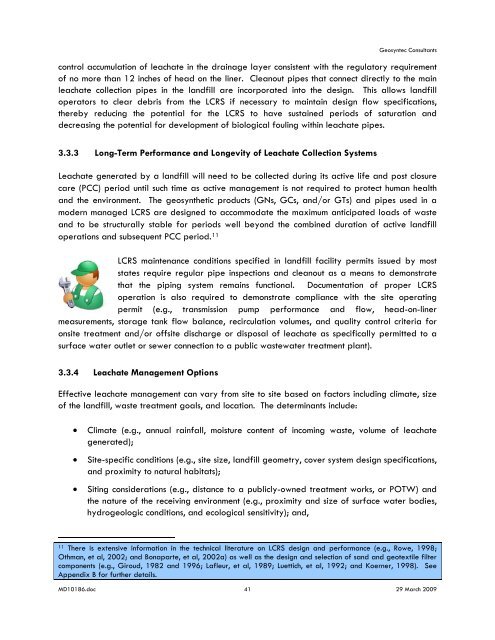AREA A/B ENGINEERING REPORT - Waste Management
AREA A/B ENGINEERING REPORT - Waste Management
AREA A/B ENGINEERING REPORT - Waste Management
You also want an ePaper? Increase the reach of your titles
YUMPU automatically turns print PDFs into web optimized ePapers that Google loves.
Geosyntec Consultants<br />
control accumulation of leachate in the drainage layer consistent with the regulatory requirement<br />
of no more than 12 inches of head on the liner. Cleanout pipes that connect directly to the main<br />
leachate collection pipes in the landfill are incorporated into the design. This allows landfill<br />
operators to clear debris from the LCRS if necessary to maintain design flow specifications,<br />
thereby reducing the potential for the LCRS to have sustained periods of saturation and<br />
decreasing the potential for development of biological fouling within leachate pipes.<br />
3.3.3 Long-Term Performance and Longevity of Leachate Collection Systems<br />
Leachate generated by a landfill will need to be collected during its active life and post closure<br />
care (PCC) period until such time as active management is not required to protect human health<br />
and the environment. The geosynthetic products (GNs, GCs, and/or GTs) and pipes used in a<br />
modern managed LCRS are designed to accommodate the maximum anticipated loads of waste<br />
and to be structurally stable for periods well beyond the combined duration of active landfill<br />
operations and subsequent PCC period. 11<br />
LCRS maintenance conditions specified in landfill facility permits issued by most<br />
states require regular pipe inspections and cleanout as a means to demonstrate<br />
that the piping system remains functional. Documentation of proper LCRS<br />
operation is also required to demonstrate compliance with the site operating<br />
permit (e.g., transmission pump performance and flow, head-on-liner<br />
measurements, storage tank flow balance, recirculation volumes, and quality control criteria for<br />
onsite treatment and/or offsite discharge or disposal of leachate as specifically permitted to a<br />
surface water outlet or sewer connection to a public wastewater treatment plant).<br />
3.3.4 Leachate <strong>Management</strong> Options<br />
Effective leachate management can vary from site to site based on factors including climate, size<br />
of the landfill, waste treatment goals, and location. The determinants include:<br />
• Climate (e.g., annual rainfall, moisture content of incoming waste, volume of leachate<br />
generated);<br />
• Site-specific conditions (e.g., site size, landfill geometry, cover system design specifications,<br />
and proximity to natural habitats);<br />
• Siting considerations (e.g., distance to a publicly-owned treatment works, or POTW) and<br />
the nature of the receiving environment (e.g., proximity and size of surface water bodies,<br />
hydrogeologic conditions, and ecological sensitivity); and,<br />
11 There is extensive information in the technical literature on LCRS design and performance (e.g., Rowe, 1998;<br />
Othman, et al, 2002; and Bonaparte, et al, 2002a) as well as the design and selection of sand and geotextile filter<br />
components (e.g., Giroud, 1982 and 1996; Lafleur, et al, 1989; Luettich, et al, 1992; and Koerner, 1998). See<br />
Appendix B for further details.<br />
MD10186.doc 41 29 March 2009

















